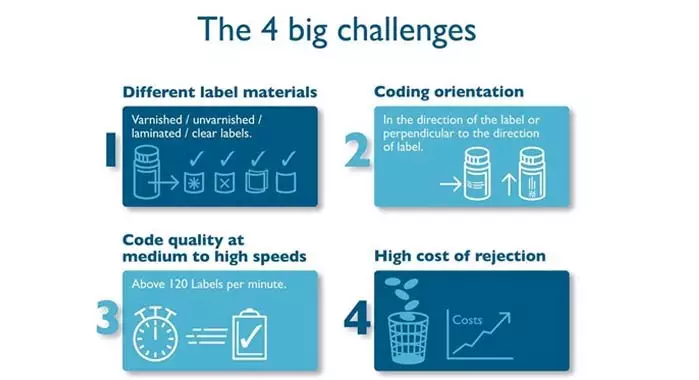Label Serialisation: Choosing the correct coding technology for US DSCSA compliances
As pharmaceutical companies are gearing up to meet the November 2018 deadline for DSCSA (Drug Supply Chain Security Act, section 582(b)(2)(A)) compliance, Domino India’s Sandeep Vadakattu looks at how to select the most suitable and versatile technology for label coding
25 Jan 2018 | By Rushikesh Aravkar
Medicines for the US market are predominantly packed in bottles, with statutory information printed on labels affixed to these bottles. With the implementation timeline extended until November 2018, it is pertinent for the pharma companies to make an informed decision in selecting optimum coding technology for their labelling lines.
There are three primary technologies deployed for marking and coding applications on different packaging materials – Thermal Transfer Overprinting technology (TTO), Thermal Inkjet technology (TIJ) and laser printing. While laser printing deploys lasers to ablate the surface of the substrate, the TTO is a ribbon-based technology which enables printing of high-resolution codes on flexible materials like plastic laminates, pouches and labels. Its performance is proven in a wide range of industries across the globe. It is essentially a contact coding technology. On the other hand, TIJ is an ink-based technology which has proven its performance in the serialisation of millions of cartons globally.

Th four big challenges
The coding technologies that are available for the manufacturers to serialise the labels (which will then be applied to the bottles) are thermal inkjets, thermal transfer printers and lasers. An informed decision will help in addressing current as well as future coding requirements.

The below table provides a detailed analysis of TIJ and TTO technologies with an objective of addressing these four big challenges:
| Challenges in serialisation | TIJ | TTO – Domino V230i |
| Different label materials / substrates | ? Suitable for unvarnished labels and labels with a porous coding area ? Does not suit for coding on varnished, laminated and clear labels. The solvent-based inks do not suit all the labels. The lower de-cap time of these inks result in code quality issues and also increases the frequency of manual intervention and cleaning. | ? Suitable for varnished, laminated and clear labels ? Different types of ribbons are available for different types of labels ? Easy changeover procedure from one ribbon to another |
| Coding orientation | ? Suitable for coding along the direction of the label ? Not suitable for coding perpendicular to the direction of the label | ? Suitable for any coding orientation – along the label or perpendicular to the label |
| Code quality in medium and high-speed lines | ? Delivers good quality codes with low rejection rates in slow speed lines of up to 100 labels per minute ? Increased rejection rate (defective codes percentage) in medium and high-speed lines- 100-300 labels per minute. TIJ prints when the label is moving. It is a non-contact coding technology. There is a tendency for vibrations of the labelling lines getting into the labels during high-speed operation which tend to result in more rejections. | ? Delivers high quality codes for speeds up to 340 labels per minute. TTO being a contact technology holds the labels while printing. Hence the vibration factor is nullified. |
| Very high-cost of rejection | Bottle along with the label gets rejected in case of poor quality codes. This results in substantial cost of rejection ? Low rejection rates on slow speed lines of up to 100 labels per minute ? Increased rejection rate on medium and high-speed lines from 100 to 300 labels per minute. As per industry experience, two percent rejection is observed on high-speed TIJ lines | ? Less than one percent rejection
|
Case Study: Impact of rejection rate on operational costs
To understand the impact of high rejection ratio on operational cost, let us look at a case-study.
Consider this:
- Line speed: 150 labels per minute
- Rejection rate with TIJ: 2%
- Rejection rate with Domino V230i TTO: 1% (Actual rejection rates are less than 1%)
The codes on labels are scanned using 360-degree camera scanners and bottles with defective codes are rejected. Please note that it is not just the label, but also the bottle that gets rejected.
Let us examine the potential cost savings when TTO is deployed instead of TIJ.
| Approximate cost of bottle with label | Rs 4 |
| Line speed (bottles per minute) | 150 |
| Savings per minute using V230i TTO instead of TIJ | 1% |
| Bottles saved from rejection per minute | 1.5 |
| Cost saved per minute | Rs (1.5 x 4) = Rs 6 |
| Savings per hour | Rs 360 |
| Savings per eight hours shift | Rs 2,880 |
| Savings per day (assuming two shifts per day) | Rs 5,760 |
| Savings per month (assuming 22 working days in a month) | Rs 1,26,720 |
| Savings per year | Rs 1,520,640 |
| Potential savings of Rs 1.5-million with Domino V230i TTO over TIJ | |
Bottle label coded with Domino V230i TTO, Grade “A”

Domino V230i TTO installation on Bottle labelling line

Customized Labeller Bracket

Domino’s labeller bracket provides great operator experience with flexibility of changing printer position in X-axis as well as Y-axis, enabling flexibility to code on different sizes of labels. The printer orientation can also be changed to suit the coding window orientation of labels.

Sandeep Vadakattu has been working with Domino Printech India since 2005. With thirteen years of experience in coding and marking industry and exposure to industries across different sectors helps him in providing deeper insights into coding technologies and their suitability for different industry applications. He is currently working as deputy general manager - life sciences sector and member of the Domino Global Life Sciences team














 See All
See All